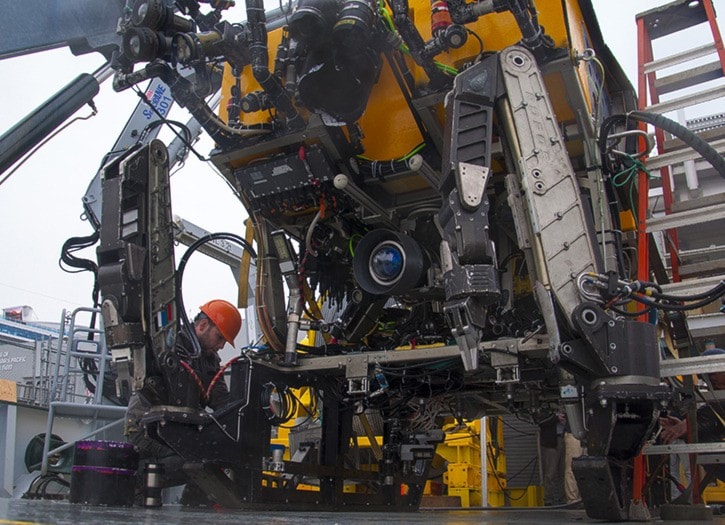Not long after Eric Schmidt spent $60 million outfitting a ship with the latest high-tech gear for marine science, Ocean Networks Canada fell onto his radar. Perhaps the former chief executive of Google googled the University of Victoria research agency.
Two years later, an 18-person scientific team from ONC has set sail from Ogden Point on the R/V Falkor to study low oxygen zones in the Saanich Inlet and the Salish Sea. The ship-time is funded entirely by Schmidt's foundation, the Schmidt Ocean Institute.
"This is a unique opportunity. Most research vessels are linked with universities or governments," says Richard Dewey, assistant director, science with Ocean Networks Canada. "This foundation has an open mandate ... this ship gives us free run to direct the science and do what we want to do."
For the next two weeks, ONC scientists will explore the ecosystems of naturally occurring low oxygen zones in the Saanich Inlet as part of a broader study to understand how low-oxygen water flows from the deep Pacific Ocean into the seas surrounding southern Vancouver Island.
Among other tools, they'll be employing ROPOS, a high-tech remotely operated vehicle, a kind of underwater robot, created by Canadian Scientific Submersible Facility based in North Saanich. Research teams from UVic and other Canadian universities will use multiple high-resolution video cameras on the boxy yellow machine to take a fine-grain look at how life survives in the inlet.
"(Today) we sail to the Saanich Inlet and will do two dives with ROPOS to explore cliff walls some 200 metres in depth, looking at organisms in low oxygen waters," said Kim Juniper, science director of ONC. "We want to capture the biodiversity between high oxygen and low oxygen zones."
On Thursday, the scientific and ship's crew prepped the Falkor, an 83-metre former German fishing boat refitted with modern laboratories, advanced sonar mapping capabilities, polished lounges, and a giant QR code on the side of a lifeboat box that link's to the Schmidt Ocean Institute website.
Jackson Chu, a UVic PhD student in marine biology and a veteran of offshore research, plans to study fish species that thrive in low oxygen ocean water. Unlike everything else on the ship, catching fish remains low-tech – he plans to use a small net.
"This is pretty awesome. It's the nicest most luxurious ship I've seen," Chu said. "It's very technically advanced with all its integrated systems."
Two years ago Schmidt Ocean Institute approached ONC and suggested it submit a research proposal. "They were looking for something to do with this vessel," Juniper said. "I'm told Eric Schmidt went online and said 'these people look interesting. Go see them.'"
Victor Zykov, director of research for Schmidt Ocean Institute, said ONC caught the institute's attention due to its Neptune and Venus underwater observatories. Neptune's 800 kilometre loop of instruments monitors the Pacific ocean off southern Vancouver Island, and Venus has 40 km of cable in the Strait of Georgia. Both feed near-real time oceanographic data through the Internet, free and open to anyone. The information is used to study everything from whales to tectonic plates.
"Providing a huge volume of real time data through the Internet is a wonderful experiment. It has allowed for new species to be discovered by citizen scientists," Zykov said. "(Neptune and Venue) were very attractive to us for the example of effectively using technology, and engaging the global community of why the oceans are so important."
Schmidt Ocean Institute pays the cost of operating the ship, about $60,000 per day using the ROPOS system, and $40,000 per day for the mapping surveys. Zykov noted that OCN's proposal was deemed the highest priority out of six competing projects from around the world.
The basis of OCN's project is to understand how water low in oxygen and high in carbon dioxide (i.e. acidic water) migrates from the deep Pacific ocean to the continental shelf, into the Strait of Juan de Fuca and beyond, a phenomenon which can stress and kill fish and shellfish. OCN scientists spent the past two weeks surveying the properties of water layers across the Neptune network to construct a complete picture of how sub-surface currents flow in and around Vancouver Island.
"Stressing the offshore environment is a growing concern," said Dewey, the lead scientist for the first phase of the project. "With low oxygen and high carbon, it's harder for fish to breathe in and harder to push out carbon dioxide. Low oxygen and high carbon environments are extremely stressful ... for all animals."
The Falkor collected some 3,000 kilometres worth of data over the past weeks from 2,800 "water columns." Even early into the analysis, the work showed that deep currents that carry ocean water toward Vancouver Island are more complicated than thought, and take different different routes than predicted.
"Our main goal was to find the pathways of the low oxygen water. Our suspected path was a dud. The main path is through Barkley Canyon, where fortunately we have Neptune," Juniper said. "Turns out we've got the network in just the right place."
Juniper hopes this project will allow OCN to create tools to forecast the movement and inflow of low oxygen water around Vancouver Island. The work will also add to the growing body of research on ocean acidification and the growth of ocean "dead zones," where water doesn't hold enough oxygen to sustain sea life.
"We are trying to understand the connection between global warming and the growth of low oxygen events," Juniper said.
"Wind patterns are changing on the coast, we're seeing more severe (winds) blowing harder and longer. It's a known phenomenon becoming more severe, but we don't know if its part of a cycle or if its going in one direction and getting worse."
See real time video feeds from ROPOS from Sept. 6 to 18 at oceannetworks.ca/cruise13.
editor@saanichnews.com
